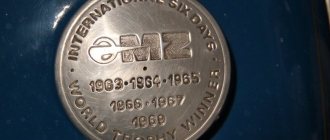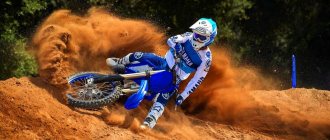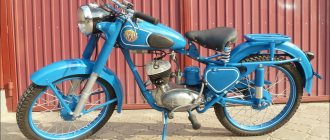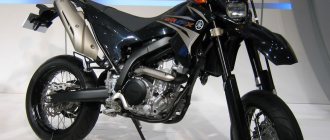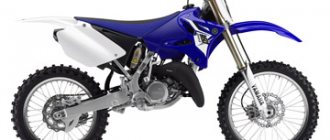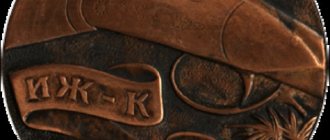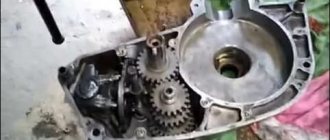First of all, it is worth noting that the front fork is one of the most important parts in the chassis of a motorcycle. And the thing is that it is precisely this that contributes to the handling, smoothness and softness of the motorcycle while riding. Let's look at the design of a simple telescopic fork. As is clear from the figure, the main parts of any telescopic fork are as follows:
• Fork legs are movable parts that fit into the fork itself.
• Springs (or shock absorbers) are parts of the fork that are necessary to absorb and smooth out impacts when hitting potholes, stones and other road irregularities. The main indicator of good spring performance is the absence of penetration of the front fork.
This means that even in the deepest holes, the springs should not be completely compressed; the feathers should remain free to move.
• Also, the design of any front fork includes all kinds of casings and oil seals, which are necessary to ensure that lubricant does not leak out of the fork while driving.
This is not a complete list, since the design of the fork largely depends on the characteristics of the individual motorcycle, but you can get the most general idea of the operation of the front fork.
Front fork Java 638:
As for the front fork of the 638 Java, the motorcycle designers have stepped far forward. The fact is that at high speeds and braking with the front brake (and as everyone knows, the front brake is the main one on a motorcycle), the front fork on many motorcycles began to screw onto the drum. And this was fraught with the motorcycle overturning and serious injuries to the pest. That is why a new telescopic fork was developed for the Java 638, using pneumatic elements that improve its performance. First of all, the design of the new fork used springs made using a special technology. The variable winding pitch made it possible to create a kind of hydraulics.
One part of the spring is less tightly wound and provides excellent shock absorption on small road irregularities. And the rest of it is made specifically to protect against penetration, and has much greater winding rigidity. This design made it possible not only to protect the fork from stress, but also to make riding the motorcycle softer and smoother, and therefore less tiring.
Another feature of the 638-Java fork was the hermetically sealed nib. This innovation helped not only to protect the insides of the fork from sand and dust, but also to create a kind of pneumatic system. After all, the fork essentially worked in a vacuum, which made it possible to reduce the load on the springs and extend their durability.
Penetration protection:
The biggest problem with all motorcycle forks is the presence of puncture. The fact is that when the fork shock absorption is not able to take a large load, it becomes rigid and all the impacts fall on the metal parts of the motorcycle. And this is fraught not only with constant repairs, but also with dangerous driving.
That is why damping springs were installed on the Java 638 fork, which were located on the fork rods. This spring has increased rigidity and enters into the depreciation process only when the main springs cannot cope with the impact force.
MY MOTORCYCLE
This article will talk about the complete disassembly of the YAVY-638 front shock absorbers.
Many motorcyclists can recall how, even after a minor accident, a practically intact motorcycle ended up with a bent front fork. More often, the upper, so-called fixed pipes and shock absorber rods bend. After replacing them, the fork becomes like new again. From time to time, the seals wear out. Replaced it and everything was fine again. Simple, in general, operations. But even here, in order not to get lost in three pines, it is better to have some kind of manual at hand or know the sequence of disassembly and assembly. This will protect you from many minor troubles - such as, for example, an “extra” part remaining after assembly.
First you need to install the motorcycle on the center stand. If you are doing repairs outside, and even on a hot day, then it would be a good idea to place a piece of plywood under the support, since the support has a tendency to push through the heated asphalt. Then remove the front wheel and fender. Before you begin dismantling the feathers, you need to drain the shock absorber fluid from them. To do this, unscrew the filler plugs 25 (Fig. 1) and then the lower drain bolts 17 . Don’t forget to place a container in advance to collect the shock absorber fluid.
Inspect the O-rings
18 under the drain bolts and, if you notice cracks on them, replace them. If you don’t have ready-made ones, you can cut them out of genuine leather using old shoes. To make it easier to dismantle the feathers, you need to make a simple device in advance. Its appearance is shown in the figure.
After the oil has been drained, loosen the M 10 bolt that clamps the fixed pipe 1 in the lower bridge and, by tapping on the device screwed in instead of the plug, remove the feather. Clean it from dirt and wipe it with a clean rag. All further disassembly must be done on a workbench or table. Using a small screwdriver, carefully loosen the fastening ring 28 and remove it with the rubber boot. Remove spring 24 and liner 33 . Using an 8mm hex key, unscrew bolt 21 and remove it. All that remains is to remove the shock absorber from the bottom of the fixed pipe - to do this you need to remove the steel ring 12 . Now the fork is completely disassembled and parts that have worn out or failed as a result of an accident can be replaced. Unfortunately, you are unlikely to find spare parts for Java in the store anymore. Therefore, let’s say, a stationary pipe or shock absorber rod, which mainly bends during collisions, will have to be sharpened yourself - fortunately, any lathe will do. After each disassembly of the pen, it is advisable to change the oil seal 15 , installed in the upper part of the movable pipe and secured there with a steel ring 16 . The oil seal has dimensions 36X X 47X6.5—10 . We provide the sizes for reference - maybe there is something suitable. Reassembling the fork is carried out in reverse order. The manufacturer advises filling in shock absorber fluid before installing the spring. This guarantees dosage accuracy. Here it is necessary to recall two very important circumstances. First, having installed the feather in the bridges of the steering column, you must immediately tighten the upper plug 25 and only after that fasten the M10 bolt in the lower bridge. And, secondly, in no case should you try to increase the efficiency of shock absorption by increasing the volume of oil against the specified amount (200 cm/cube for each feather). If there is a need to make the fork more rigid, you can fill in a more viscous shock absorber fluid - but in the same quantity. This sometimes has to be done under severe operating conditions, especially in rural areas, as well as at elevated seasonal temperatures or high wear on the shock absorber.
We can end on this note. Repair and take care of your motorcycle......
content .. 21 22 27 ..Malfunctions of the front fork stays of motorcycles Java-250, Java-350
Knocks and noises. In order to more easily understand the reasons that cause knocking and noise in the front fork legs, knocking and noise should be divided into two groups. The first group of knocks are knocks that arise from the movement of fork parts in the longitudinal plane of the motorcycle and to the sides from it. These knocking noises occur, for example, when driving on a smooth cobblestone road. It should be emphasized that driving on cobblestone roads is the best way to identify parts that are rattling, loose or operating with abnormal clearances. The knocking sound of the fork guards is the very first extraneous sound that occurs in the front fork. It is detected even during the break-in period of the motorcycle. This sound occurs due to the covers touching the front wheel mudguard brackets. The sound of friction is accompanied by rattling of the casings, especially when driving on cobblestones. To eliminate friction (touching) of the casings with the brackets, it is necessary to file the ribs of the brackets in the places where the casings touch them. These places are easily identified by abrasions. The sawed areas should be painted. The creaking of springs under the casings occurs as a result of sand getting under the casing and on the springs and due to a lack of lubrication on the springs and on the internal surfaces of the casings. This creaking is eliminated after removing the fork leg by lubricating the springs and internal surfaces of the casings with grease 1-13. Friction and creaking of the tip gland nut on the inner surface of the casing occurs when the guide ring on the tip nut is worn out, as well as when there is a lack of lubrication on the inner surface of the casing. Friction and creaking are eliminated by lubricating the inner surface of the casing with grease 1 - 13, and if the ring wears out, by installing a new ring. The knocking sound of the movable tip of the fork leg occurs when the fork leg guide bushings are worn excessively. Moreover, it is typical that when the bushings wear out, knocking noises become more frequent when the fork is fully compressed and during its reverse stroke. This happens because, structurally, the bushings, together with shock-absorbing oil, play the role of additional buffers that operate at the end of the tip stroke and on its return stroke. The wear of the fork leg guide bushings is determined with the motorcycle wheel raised. After installing the motorcycle on the stand, the feathers are swung by hand in the plane of movement of the motorcycle. If the bushings are significantly worn, there will be noticeable play in the moving tips on the main pipes, and a knocking sound will also be heard in the feathers. This play and knocking should not be confused with play and knocking in the steering column bearings. Worn bushings should be replaced. The second group of knocks are knocks that occur at the end of the reverse or forward stroke of the fork. These knocking noises occur when driving on bumpy roads or rough terrain, when the front wheel either completely compresses the fork or hangs in the air. The knocks of the fork when it is engaged all the way and on the reverse stroke are difficult to confuse with other knocks in the fork, since they occur in the appropriate situation (bad road) and are felt with sharp blows in the driver’s hands. Knocks in the fork when it is pulled all the way (upper or lower) occur for various reasons. When they appear while driving on a bumpy road, they are caused either by inept driving or by the high speed of the motorcycle, which does not correspond to the condition of the road. If the driver is good at driving on rough roads, then knocking noises may appear as a result of insufficient viscosity of the shock absorber oil poured into the fork or due to an insufficient amount of shock absorber oil. In both cases, the oil needs to be changed. If the knocking does not stop after changing the oil, you can fill in a more viscous mixture. The viscosity of the oil must correspond to the ambient temperature. If sequential replacement of shock-absorbing oil (in
limits of viscosity that ensure normal shock absorption) does not stop knocking, especially when the fork is reversed, then knocking can be the result of one or a combination of several of the following reasons: 1. Wear of the fixed pipe bushings and the movable tip bushing. Determining the degree of bushing wear is described above. 2. Defects in the hydraulic shock absorber. The following problems may occur in a hydraulic shock absorber: 1. The piston jumps off the rod as a result of unscrewing the piston nut. 2. Unscrewing the rod from the conical tip. Problems due to wear of hydraulic shock absorber parts practically do not arise, since the piston operates in the cylinder with a large gap and does not wear out for a very long time (if the guide bushings of the movable tip and the fixed pipe are changed in a timely manner), and the plate valve lasts even longer. The operation of the hydraulic shock absorber is checked after removing the feather from the bridges. When checking, you need to squeeze the pen to the end, holding it vertically, then pull the movable tip down. If the movable tip moves up and down freely with noticeable resistance, especially when moving it suddenly, then the hydraulic shock absorber parts are in good condition. If the movable tip goes down without noticeable resistance, then it is necessary to disassemble the pen to repair the hydraulic shock absorber. You can check the operation of the hydraulic shock absorber on motorcycle models 353/04 and 354/04 as follows: a) remove the fuse for the electrical circuit and remove the upper headlight casing, unscrew the upper screw plug 6 and pull out the rubber plug; b) squeezing the fork leg, lift the plugs 6 and fix the rod by the flats with a 5 mm wrench; c) unscrew the lock nut 8 of the rod 11 and unscrew the threaded plug 6 from the rod; d) screw the device onto the rod (see Fig. 99, a) and, holding it in your hand, move the rod up and down. When the shock absorber is working properly, the rod should go down easily and go up with significant resistance created by the work of the piston. Resistance should be especially felt when the rod moves sharply upward (with a jerk). The rod will move upward without noticeable resistance if the shock absorber parts are heavily worn or the viscosity of the shock absorber oil is low. If oil of the appropriate viscosity is filled and the rod moves upward without noticeable resistance, the shock absorber should be disassembled for repair. Leaking shock absorber oil from the fork legs. Oil from the fork legs may leak out from under the plug bolt closing the drain hole and near the movable tip oil seal nut. The reasons for shock absorber oil leakage from the plug bolt may be the following: 1) weak tightening of the plug bolt; 2) damage to the gasket underneath; 3) uneven contact surfaces at the tip or washer.
The following reasons can cause oil leakage from the oil seal nut: 1. Weak tightening of the nut on the tip. In this case, the nut must be tightened using the wrench shown in Fig. 65. When tightening the gland nut, remember that it is screwed onto a movable tip. The nut on the movable tip is tightened by turning it clockwise if you look at the pen from above, and vice versa if you look at the nut from below (under the pen housing). 2. Damage to the fiber seal in the nut. The fiber seal can be damaged by the uneven surface of the tip end. 3. Uneven upper plane at the end of the fork tip. The flatness of the end can be damaged if the tip is carelessly disassembled or stored. 4. The rubber seal of the nut is worn. The worn oil seal is replaced with a new one. Usually, simultaneously with the wear of the rubber seal, other parts of the nut also wear out. Therefore, if wear of the oil seal is detected, the nut and oil seal assembly should be replaced. 5. Longitudinal deep marks on fixed pipes. Even a new rubber seal cannot stop the oil seeping along the grooves. A pipe with deep longitudinal grooves must be ground and polished or replaced with a new one. 6. Oil may be thrown out through the air valve if the oil is poured into the fork more than 150 cm3 on motorcycles of models 353/04 and 354/04.
Rice. 65. Device for tightening the nut-gland of the front fork leg without disassembling it: a - dimensions of the device; b - installation of the device on the pen; 1 - knob; 2 - device; 3 - gasket; 4 — movable pen tip.
content .. 21 22 27 ..
About how to cross a CZ Cross plug and a Java 12V (Report)
I promised to unsubscribe for a long time... First, a little background: I somehow came across the feathers from a CZ Cross fork. I installed them in the original traverses using conical plugs. I looked at the glasses - on the left there is no meat at all (I ground the end of the axle to 15 mm), and on the right there seems to be enough meat to bore it to the diameter of the opposite axle and bored it out. This was the mistake; after a few years the axle mount cracked and had to be reinforced with steel clamps. Then I installed custom-made WIDE crossbars, the fork finally stood up without distortions, and it turned out that the standard Chezov springs were sorely lacking (By that time, one and a half sets of the original crowbars were already irretrievably lost). It punched all the way on almost any bump. It was decided to buy glasses from Java and springs from the boxer (I forgot to buy the springs at first, and then did without them. But there were no glasses separately, I had to buy an assembled fork)
So let's move on to the actual crossing. Both forks have a 36mm stay diameter and a rodless design. This is where the coincidences end. The piston doesn’t fit from one to the other, it’s Java on top, Chezov’s on bottom:
We use pistons from Chesa. In order to prevent the fork from simply falling apart during the reverse stroke, instead of the rebound spring, I installed a piece of a Chezov spring. In addition, Java has a bolt securing the piston M10, while Cheza has M8, which is compensated by a thick washer of the adjusted size. I inserted the pistons into crowbars and secured them with a lock washer to increase the stiffness of the spring, I did it like this:
In total, 2 springs work for compression, the long one in the normal place and the short one. As it turned out, the rigidity for asphalt and leisurely maneuvering on the primer is very good. In addition, the travel of the fork has been reduced quite significantly (It may not be enough over bumps, but for the road it’s quite enough...). For those who need more travel, use one opposed spring.
We assemble everything as usual, I made one improvement - I installed a second oil seal, glued it with sealant and fixed it with a piece of rubber (The fork is already quite worn out, and oil is leaking.)
Corrugations from the steering rack of a VAZ 2108 (I don’t even want to pick up what we sell for Java - it will crumble very quickly, and this has been going on for several years now.) The combined spring is what’s left of the Chezov ones plus the Java ones through a washer.
Naturally, the left blade was drilled out in advance to the size of the opposed axle; during assembly, I had to slightly grind off the head of the piston bolt, otherwise it would interfere with the axle.
In total, I got a classic-looking fork for almost nothing (Without offset compensation, which, by the way, really bothered me. Either too small or too big).
The length from the center of the wheel axle to the end of the fork is about 925 mm without plug.
If anything is unclear, ask, by the way, I again came across a fork with different feathers, on one the paint is factory - you can tear it off, on the second it looks like it’s self-oiled - it will peel off...
Java 350 fork repair
Many motorcyclists can recall how, even after a minor accident, a practically intact motorcycle ended up with a bent front fork. More often, the upper, so-called fixed pipes and shock absorber rods bend. After replacing them, the fork becomes like new again. From time to time the seals wear out. Replaced it and everything was fine again. Simple, in general, operations. But even here, in order not to get lost in three pines, it is better to have some kind of manual at hand or know the sequence of disassembly and assembly. This will protect you from many minor troubles - such as, for example, an “extra” part remaining after assembly.
fork
This article, prepared based on materials from the Czechoslovak Motor Review magazine, will talk about the complete disassembly and repair of the Java 350 front fork . First you need to install the motorcycle on the center stand. If you are doing repairs outside, and even on a hot day, then it would be a good idea to place a piece of plywood under the support, since the support has a tendency to push through the heated asphalt. Then remove the front wheel and fender.
Before you begin dismantling the feathers, you need to drain the shock absorber fluid from them. To do this, unscrew the filler plugs 25, and then the lower drain bolts 17. Do not forget to place a container in advance where the shock absorber fluid will drain.
Inspect the O-rings 18 under the drain bolts and, if you notice cracks on them, replace them. If you don’t have ready-made ones, you can cut them out of genuine leather using old shoes.
To make it easier to dismantle the feathers, you need to make a simple device in advance. Its appearance is shown in the figure. After the oil has been drained, loosen the M10 bolt that clamps the fixed pipe 1 in the lower bridge and, tapping on the screwed-in 24 and the liner 33. Using an external hex key “8”, unscrew bolt 21 from the bottom of the movable pipe and remove it. All that remains is to remove the shock absorber from the bottom of the fixed pipe - to do this you need to remove the steel ring 12.
Now the Java 350 fork is disassembled and ready for repair; parts that have worn out or failed as a result of an accident can be replaced. Unfortunately, you are unlikely to find spare parts for Java in the store anymore. Therefore, let’s say, a stationary pipe or shock absorber rod, which mainly bends during collisions, will have to be sharpened yourself - fortunately, any lathe will do.
After each disassembly of the pen, it is advisable to change the oil seal 15, installed in the upper part of the movable pipe and secured there with a steel ring 16. The oil seal has dimensions 36X X 47X 6.5-10. We inform you for reference - maybe there is something suitable...
Reassembling the fork is carried out in reverse order. The manufacturer advises filling in shock absorber fluid before installing the spring. This guarantees dosage accuracy.
Here it is necessary to recall two very important circumstances. First, having installed the feather in the bridges of the steering column, you must immediately tighten the upper plug 25 well and only after that fasten the M10 bolt in the lower bridge. And, secondly, in no case should you try to increase the efficiency of depreciation by increasing the volume of oil against the specified amount (200 cm3 for each feather). If there is a need to make the fork more rigid, you can fill in a more viscous shock absorber fluid - but in the same quantity. This sometimes has to be done under severe operating conditions, especially in rural areas, as well as at elevated seasonal temperatures or high wear of the shock absorber.
The material was published in the magazine "Moto".
Jawa Club - Java motorcycle: history, photos, tuning, repair, maintenance.
| Recorded by |
